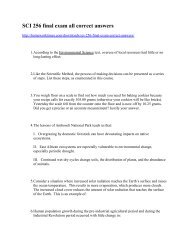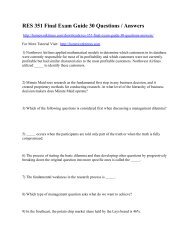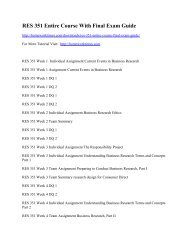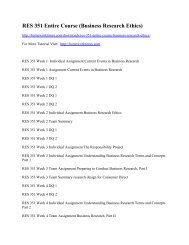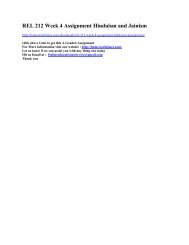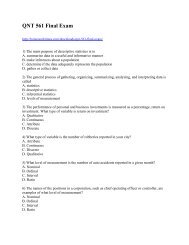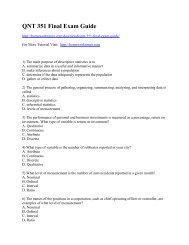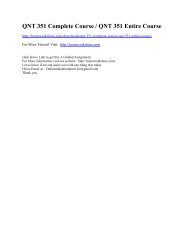RES 341 Entire Course / RES 341 Complete Course
Create successful ePaper yourself
Turn your PDF publications into a flip-book with our unique Google optimized e-Paper software.
<strong>RES</strong> <strong>341</strong> <strong>Entire</strong> <strong>Course</strong> / <strong>RES</strong> <strong>341</strong> <strong>Complete</strong> <strong>Course</strong><br />
http://homeworktimes.com/downloads/res-<strong>341</strong>-entire-course-res-<strong>341</strong>-complete-course/<br />
For More Tutorial Visit: http://homeworktimes.com<br />
<strong>RES</strong> <strong>341</strong> <strong>Complete</strong> <strong>Course</strong> Material<br />
<strong>RES</strong> <strong>341</strong> <strong>Entire</strong> <strong>Course</strong><br />
<strong>RES</strong> <strong>341</strong> Week 1 <strong>Complete</strong> DQs<br />
(1) How would you define research? What is the purpose of business research? How has the<br />
Internet changed the quality and quantity of research?<br />
(2) Should an organization create research testing for all problems confronting the business?<br />
Why or why not? When is it appropriate to use exploratory research? Can decision-making be<br />
accomplished by using only descriptive research? Why or why not?<br />
(3) What is the reliability of a measurement? What is the validity of a measurement? Can a<br />
measurement be valid if it is not reliable? Explain.<br />
<strong>RES</strong> <strong>341</strong> Week 1 Individual Assignment Current Business Research Project PaperGreen<br />
Products<br />
<strong>RES</strong> <strong>341</strong> Week 1 Exercise 4.4<br />
<strong>RES</strong> <strong>341</strong> Week 2 <strong>Complete</strong> DQs
(1) What are some of the differences between primary and secondary data? What are some<br />
disadvantages of using newspaper articles or magazine articles as secondary sources? Why<br />
should you use both primary and secondary data in research?<br />
(2) How valid/reliable are the statistics presented on the evening news? Why should we be<br />
concerned with errors resulting from questionnaire design? How do research design and<br />
statistical information affect validity?<br />
(3) What is a real-world example of a sample? A population? Compare and contrast probability<br />
sampling with non-probability sampling, giving an example of each.<br />
<strong>RES</strong> <strong>341</strong> Week 2 Individual Assignment Research Terminology Matching Assignment<br />
<strong>RES</strong> <strong>341</strong> Week 3 <strong>Complete</strong> DQs<br />
(1) What is decision theory? What is the difference between a payoff table and an expected<br />
payoff table? In the following payoff table, let P(S1) = 0.30, P(S2) = 0.50, and P(S3) = 0.20.<br />
Compute the expected monetary value for each of the alternatives. What decision would you<br />
recommend?<br />
(2) What are some differences between discrete and continuous data? Is the measurement of<br />
money continuous or discrete? Explain. Can discrete data be analyzed using a normal<br />
distribution? Why or why not?<br />
(3) Describe the properties of a normal distribution. Explain why there are an infinite number of<br />
normal distributions. Why do we want to assume that our sample data represent a population<br />
distribution?<br />
<strong>RES</strong> <strong>341</strong> Week 3 Individual Assignment Survey Paper Topic Major League Baseball
<strong>RES</strong> <strong>341</strong> Week 3 Individual Assignment Survey Paper Topic Self-efficasy and cigarrete<br />
smoking<br />
<strong>RES</strong> <strong>341</strong> Week 3 Individual Assignment Survey Paper Topic Wage Earners<br />
<strong>RES</strong> <strong>341</strong> Week 3 Statistical Symbols and Definitions Matching Assignment<br />
<strong>RES</strong> <strong>341</strong> Week 4 <strong>Complete</strong> DQs<br />
(1) Why is the population shape a concern when estimating a mean? What effect does sample<br />
size, n, have on the estimate of the mean? Is it possible to normalize the data when the<br />
population shape has a known skew? How would you demonstrate the Central Limit Theorem to<br />
your classmates?<br />
(2) What do confidence intervals represent? What is the most controllable method of increasing<br />
the precision (narrowing) of the confidence interval? What percentage of times will the mean<br />
(population proportion) not be found within the confidence interval?<br />
(3) A mayoral election race is tightly contested. In a random sample of 1,100 likely voters, 572<br />
said that they were planning to vote for the current mayor. Based on this sample, what is your<br />
initial hunch? Would you claim with 95% confidence that the mayor will win a majority of the<br />
votes? Explain.<br />
<strong>RES</strong> <strong>341</strong> Week 4 Individual Assignment Exercises From the E-Text 5.62 5.70<br />
<strong>RES</strong> <strong>341</strong> Week 4 Individual Assignment Article Review<br />
<strong>RES</strong> <strong>341</strong> Week 4 Exercise 4-2 Confidence Interval<br />
<strong>RES</strong> <strong>341</strong> Week 4 R5 Quiz<br />
<strong>RES</strong> <strong>341</strong> Week 5 <strong>Complete</strong> DQs
(1) A significance test is used to prevent a machine from under filling or overfilling quart bottles.<br />
On the basis of a sample, the null hypothesis is rejected and the machine is shut down for<br />
inspection. A thorough examination reveals there is nothing wrong with the filling machine.<br />
From a statistical standpoint, was there a “type” error made? If yes, which type? Explain<br />
(2) Suppose that you perform a significance test regarding a population mean, and that the<br />
evidence does not warrant rejection of the null hypothesis. When formulating the conclusion to<br />
the test, why is the phrase “fail to reject the null hypothesis” more accurate than the phrase<br />
“accept the null hypothesis”? Why can the null hypothesis not be proved? Explain.<br />
(3) A man is on trial accused of murder in the first degree. The prosecutor presents evidence that<br />
he hopes will convince the jury to reject the hypothesis that the man is innocent. This situation<br />
can be modeled as a significance test with the following hypotheses:<br />
<strong>RES</strong> <strong>341</strong> Week 5 Individual Assignment Exercises From the E-Text Chapters 5 and 6<br />
Exercises 8.46 and 8.62<br />
<strong>RES</strong> <strong>341</strong> Week 5 Individual Assignment Using Probability Distribution in Research<br />
Simulation<br />
<strong>RES</strong> <strong>341</strong> Week 5 Quiz<br />
<strong>RES</strong> <strong>341</strong> Week 5 Final Exam 8 versions Consolidated



